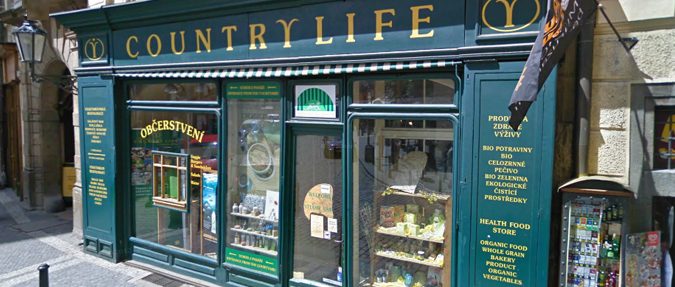Watching what you eat to lose weight, or simply paying attention to what you put in your body, often means scrutinizing nutrition labels and ingredients lists before buying. That’s hardly an easy task when said information appears in a foreign language. To help you shop smarter and eat better, we spoke with Monika Divišová, nutritional consultant, wellness coach, and director of Prague-based weight-loss management center Wellnessia, who offered Expats.cz readers tips for filling your grocery basket with the good health.
10. It’s possible to eat healthy without going entirely green.
Ms. Divišová says that while the easiest way to shop for good-quality, healthful products is to hit the health-food stores (“biopotraviny” like Country Life, etc.) those who can’t for budget reasons should, at the very least, opt for organic-quality meat. Why? “Commercially-raised animals eat food that has been chemically treated and may be fed antibiotics. These two things can cause allergies, migraines, skin problems, obesity, and other health issues.” The popular foodie web site Scuk.cz recommends meat from Biofarma Sasov—you can find their products at these Prague shops.
9. Keep in mind that organic doesn’t equal low-calorie.
Calorie counters may be misled by packaging that reads “zdrave” (healthy), “celozrnná” (whole-grain) or “bio” (organic). These words don’t necessarily indicate reduced-calorie or low-fat products. White and wholegrain breads, says Divišová, have around the same amount of calories; wholegrain breads, however, rack up about 70 percent more nutrients. If you’re keeping an eye on calories and fat the most important key words are: “plnotučný” (full-fat), “polotučný” (half-fat), “bez tuku” (fat-free), and “linea”, “linie”, or “lehký” (light; can refer to fat or sugar).
8. Learn the different labeling systems.
While the EU currently solidifies its food-labeling laws, you’ll likely come across products that feature a hodgepodge of dietary details. Most common in the Czech Republic are labels that list nutritional values per 100 g (3.5 oz) or 100 ml (about 1/2 cup) for “kcal” (calories), “bílkovina” (protein), “sacharidy” (carbohydrates), “tuk” (fat), “cukr” (sugar) and in some cases “nasycených tuků” (saturated fat), “vlákno” (fiber), and “sodík” (sodium). Some manufacturers have begun putting Guideline Daily Amounts (GDA)—simplified per-portion “traffic-light style” nutrition labels—on package fronts. This website devoted to GDA is a helpful English-language resource.
7. Brush up your consumer Czech.
More and more Czechs are demanding to know exactly what’s in their food. Some brands use number-letter codes (e.g. E110 is yellow dye no. 3) to indicate the presence of “barvivo” and “konzervant” (artificial colors and preservatives) and icons to signify food that is “bez lepku” (gluten-free) or of “živočišný původ” (animal origin). For help deciphering ingredients lists and other important consumer information, visit Emulgatory.cz for a run-down of dyes, preservatives, emulsifiers, and additives by illustration and code, as well as a list of harmful ingredients to avoid. The site also provides a database of articles on nutrition trends and topics.
6. Choose your bread wisely.
Ms. Divišová suggests avoiding processed “toustový chléb” (sliced bread) which has the highest sugar content and lacks nutritional value and fiber. She warns that most of those lovely looking loaves at the supermarkets pack loads of additives to keep them fresher longer and suggests buying wholegrain bread at one of Prague’s numerous “bio pekařství” (Divišová likes Govinda) or even from DM Drogerie, which stocks bread and a wide array of good-for-you groceries as well. When at the supermarket, opt for wholegrain bread by Penam. Note that law requires stores to provide nutritional info for fresh bread on demand.

Country Life – Health-food store in Melantrichova Street
5. Get your game on!
Wild game “zvěřina” like “jelen” (venison), “králík” (rabbit), and “kachna” (duck), is widely available in the Czech Republic and can be much leaner than its domestically raised counterparts, as can “klokan” (kangaroo meat) which can be found in a number of Prague supermarkets. For traditionalists seeking healthier beef, cuts from the back leg bone—the cow primarily uses its back legs as a means of movement—are leanest. Ask the butcher for meat from the “zadní” (rear) such as “z válečku” (eye of round roast). Opt for “kotlety z vepřové panenky” (pork loin chops) or “kuřecí prsa” (chicken breast). Ground turkey is “mleté krůtí maso.”
4. Explore healthful alternatives to white rice and pasta.
Grains are the way to go when you want to scale back on refined carbs. Divišová also says, “It’s important to include a variety of food in your diet to enhance nutrients.” Not a problem for Prague shoppers who can chose from a wide selection of grains at the supermarket. Check the bio or foreign foods sections or health-food store for: “neloupaná rýže” (brown rice) “celozrnný kuskus” (wholegrain couscous), “špalda” (spelt), “pohanka” (buckwheat), “proso” (millet), “ječné kroupy” (groats), barley “ječmen” (barley), and “oves” (oats). Quinoa, polenta, and bulgur are labeled as such.
3. Know which cooking oils to avoid.
Steer clear of highly-processed, low-quality vegetable oil and instead choose oils that are high in heart-healthy monounsaturates and oleic acids and omega-3 fatty acids. For sautéing use “světlicový olej” (safflower oil) and “panenský olivový olej” (virgin olive oil), for high-heat cooking choose organic “řepkový olej” (canola or rapeseed oil), “arašídový olej” (peanut oil), or “sezamový olej” (sesame oil). Reserve ultra-healthy, yet fragile, “extra panenský olivový olej” (extra-virgin olive oil) for dressings. Divišová also recommends “kokosový olej” (coconut oil), available at healthful stores, as a substitute for vegetable oil in baking and sautéing.
2. Rethink desserts using supermarket finds.
Divišová suggests the following healthy desserts to her clients: low-fat white yogurt and sunflower seeds sweetened by Glukopur, a natural grape sugar found on supermarket shelves; apple compote with raisins and cinnamon, cooked in 100 percent apple juice; grated carrot and apple, with raisins and coconut shreds; a “tvaroh” (quark) smoothie with yogurt, frozen berries, and bananas. She says to avoid “umělé sladidlo” (artificial sweeteners) and try Stevia, a refined, plant-derived sweetener that’s available at health food stores and pharmacies, instead.
1. Watch out for so-called “healthy” foods—they might be sugar bombs.
Some foods that you may think are healthy actually contain loads of sugar. Divišová points to low-fat yogurt and other dairy products especially. “They might have a lower fat content but come with high amounts of sugar and starch,” she says. Play it safe with 3% fat white yogurts (brands like Hollandia and Bio Olma). Crunchy cereals, too, says Divišová, are full of corn syrup, chocolate, and sugar. She suggests making your own homemade muesli; “ovesné vločky” (rolled oats) are cheap and available at any supermarket. Use dried fruits sparingly.
Related articles












 Reading time: 5 minutes
Reading time: 5 minutes 




















